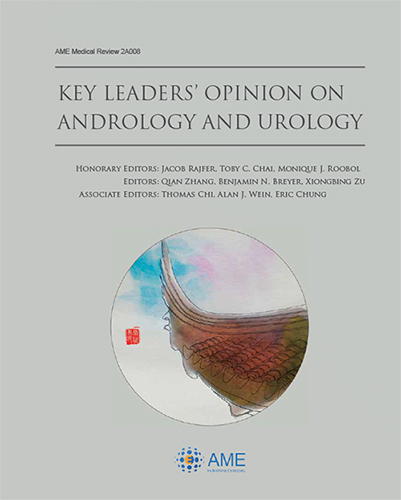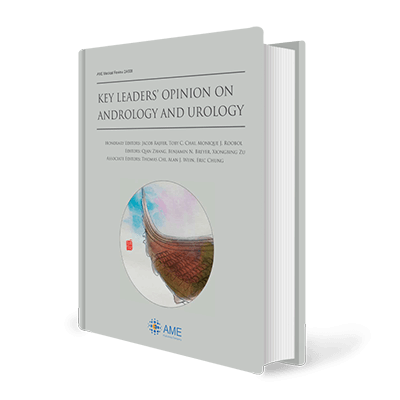18 The link between metabolic syndrome and nephrolithiasis: a white whale for understanding urinary stone disease
Thomas Chi, Eric Taylor, Marshall L. Stoller
19 Moderation may be the best fad diet for urinary stone disease
Thomas Chi, Eric Taylor, Marshall L. Stoller
20 Mast cell activation syndrome
Vicki Ratner
Treatment Progress
22 Diagnosis and treatment of benign prostate hyperplasia in Asia
Keong Tatt Foo
28 Erectile dysfunction: Doctors’ perspectives on patients’ concerns
Katherine L. Ji, Liang-Jun Gu
31 Continuous or intermittent? On the dosing schedule of sunitinib for advanced renal cell carcinoma
Masahiro Nozawa, Hirotsugu Uemura
33 Modifying sunitinib schedule in advanced kidney cancer patients: Re ections from the results of the renal EFFECT trial
Camillo Porta, Carlo Ganini, Chiara Paglino
36 The complexity of sunitinib dosing in renal cell cancer patients
Ingrid M.E. Desar, Sasja F. Mulder, Peter F.A. Mulders, Carla M.L. van Herpen
39 Towards new treatment options for renal cell carcinoma: development and clinical results of tivozanib, a selective VEGFR tyrosine kinase inhibitor
Ferry ALM Eskens, Brigitte Haberkorn
41 Milestones for development of tivozanib for kidney cancer therapy
Robert Crescentini, Shilpa Gupta, Mayer Fishman
44 Could tivozanib be a new potent pan-VEGF inhibitor in RCC therapy?
Zsuzsanna Mihály, Alexisz Panajotu, Balázs Győrffy
46 Tivozanib: is total VEGFR inhibition the way to success in terms of tolerability and ef cacy in advanced kidney cancer?
Marine Gross-Goupil, Alain Ravaud
48 Tivozanib: a novel VGFR inhibitor for kidney cancer
Helen Boyle
51 Enzalutamide (formerly MDV3100) prolongs survival in docetaxelpretreated castration-resistant prostate cancer patients
Matthias M. Heck, Jürgen E. Gschwend, Margitta Retz
53 Enzalutamide: the emperor of all anti-androgens
Emmanuel S. Antonarakis
55 Denosumab: Delay of bone metastasis in men with nonmetastatic castrate-resistant prostate cancer
Jules P. Manger, Tracey L. Krupski
57 Prevention of bone metatasis in prostate cancer by denosumab: Unneeded endpoint or unmet need?
Carsten-Henning Ohlmann
60 Extension of the therapeutic spectrum in castration-resistant prostate cancer: Osteoclast inhibition with denosumab
Johannes M. Wolff, Hans-Peter Schmid
62 Identi cation of biomarkers in pazopanib treated patients with renal cell carcinoma
Amy M. Pick, Zara Risoldi Cochrane
64 Proposal of “cyclic therapy”, a novel treatment strategy with targeted agents for advanced renal cell carcinoma
Masahiro Nozawa, Hirotsugu Uemura
68 Does patient-tailored immunotherapy pave the way for new renal cell carcinoma treatment perspectives?
Ilse Van Brussel, Amaryllis H. Van Craenenbroeck, Dorien M. Schrijvers, Nathalie Cools
72 Immunotherapy in renal cell cancer: the more the merrier?
Jorge Camarero, Sol Ruiz
75 The argument for palliative care in prostate cancer
Melissa T. Sanford, Kirsten L. Greene, Peter R. Carroll
78 Greenlight laser vaporization versus transurethral resection of the prostate for the treatment of benign prostatic obstruction: evidence from randomized controlled studies
Mostafa M. Elhilali, Mohamed A. Elkoushy
83 Comprehensive characterization of the perioperative morbidity of cytoreductive nephrectomy
Andrew Leone, Gregory Diorio, Kamran Zargar-Shoshtari, Philippe E. Spiess
86 What’s new in urological trauma? 2012 update
Benjamin N. Breyer, Jack W. McAninch
88 Interpretation of PIVOT ndings
Sergey Shikanov
90 Re ning treatment for the men who need it: lessons from the PIVOT trial
Michael R. Abern, Matvey Tsivian, Thomas J. Polascik
93 PIVOT and the challenges of localized prostate cancer care
Aviva E. Weinberg, James D. Brooks
96 Complete remission with tyrosine kinase inhibitors in renal cell carcinoma
Yoshihiro Wada, Kenichiro Tanoue, Wataru Takahashi, Masatoshi Eto
99 Neuromodulation and neurostimulation: overview and future potential
Emil A. Tanagho
105 Gastric bypass surgery patients warrant special attention for preventing urinary stones
Thomas Chi, Eric Taylor, Marshall L. Stoller
106 Ureteral stents are part of an ever-expanding technology horizon
Thomas Chi, Eric Taylor, Marshall L. Stoller
107 Injection therapy for Peyronie’s disease: pearls of wisdom
William O. Brant, Amanda Reed-Maldonado, Tom F. Lue
111 Looking beyond the guidelines for perioperative antibiotics in nephrolithiasis
Thomas Chi, Eric Taylor, Marshall L. Stoller
112 Should perioperative anticoagulation be an integral part of the priapism shunting procedure?
Tom F. Lue, Maurice Garcia
New Technique
117 Clinical challenges in tissue-engineered urethral reconstruction
Sophie Ramsay, Cassandra Ringuette-Goulet, Alexandre Langlois, Stéphane Bolduc
121 Predicting the future of urodynamics
Ariana L. Smith, Alan J. Wein
Prognosis
123 Predicting response to neoadjuvant chemotherapy in bladder cancer: controversies remain with genomic DNA sequencing
Roland Seiler
126 New prognostic models in metastatic renal cancer
Louise Lim, Tom Powles
128 Is there a sexual life after treatment of cancer?
Luca Incrocci
Special Case Analysis
131 Commentary on refractory ischemic priapism
Maurice Garcia, Sima Porten, Tom F. Lue
136 Commentary on high ow, non-ischemic, priapism
Alex K. Wu, Tom F. Lue
140 Commentary on the myths of Peyronie’s disease
Alex K Wu, Tom F Lue
146 Randall plaque versus renal stone?
Thomas Chi, Joe Miller, Marshall L. Stoller
Cost Effective Management
151 The days of cost effective management for nephrolithiasis are already upon us
Thomas Chi, Eric Taylor, Marshall L. Stoller
152 Balancing the utility of new technology against cost in urinary stone disease
Thomas Chi, Eric Taylor, Marshall L. Stoller



